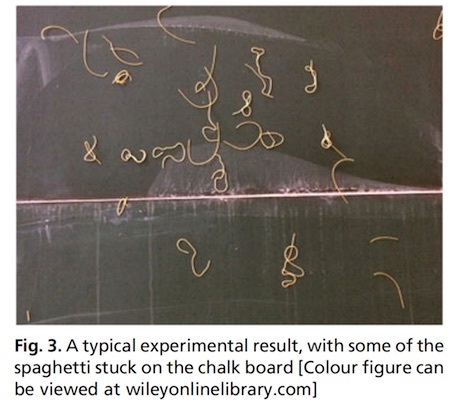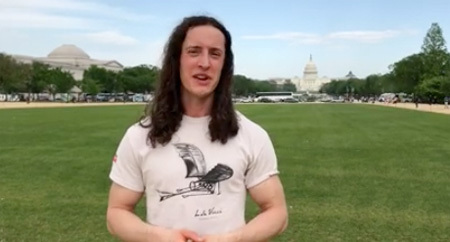Marc Abrahams's Blog, page 197
January 25, 2018
A new life portrait of Troy, the inventive, prize-winning Grizzly Suit-of-Armor inventor
Troy Hurtubise enjoys and does not enjoy a deep biographical look at him that’s headlined “HE WAS A VIRAL SENSATION BEFORE THE INTERNET CHEAPENED THAT STATUS.” Troy was awarded a 1998 Ig Nobel Prize in the field of Safety Engineering, for developing, and personally testing a suit of armor that is impervious to grizzly bears.
Here’s the documentary film about Troy, “Project Grizzly“, produced in 1996 by the National Film Board of Canada:
Troy has had many adventures, quite a few of which we have chronicled here. He is a an exemplar of perseverance and fortitude, and other qualities.
BONUS: Additional news today, about a different Ig Nobel Prize winner.

High-tech use for garlic skin – supercapacitors (new study)
Attention electronic engineers – stuck for a suitable material for creating supercapacitor electrodes? Have you thought about carbonized garlic skin? If not, may we recommend a new research paper scheduled for publication in the journal Nanoscale – entitled ‘Synthesis of Garlic Skin-Derived 3D Hierarchical Porous Carbon for High-Performance Supercapacitors’.
Researchers Qing Zhang, Kuihua Han, Shijie Li, Ming Li, Jinxiao Li and Ke Ren of the School of Energy and Power Engineering at Shandong University, China have discovered that a “facile” chemical activation process can turn ordinary garlic skin into a super high-tech electrode material :
“ … the as-obtained carbon exhibits a hierarchical porous structure, which provides ideal channels for ion diffusion with low migration resistances, enabling an excellent rate performance and cycling stability in aqueous electrolytes. The garlic-skin-derived 3D hierarchical porous carbon, therefore, becomes a promising electrode material for supercapacitors.”
Their garlic-skin-based supercapacitors withstood 5,000 changing/discharging cycles, with a capacitance retention as high as 94%.

January 24, 2018
J.S. Milne’s “Tips for Authors”
 J.S. Milne (pictured here) wrote a list of “Tips for Authors.” Though intended for mathematicians, it may be equally useful to others. Milne’s list begins with this:
J.S. Milne (pictured here) wrote a list of “Tips for Authors.” Though intended for mathematicians, it may be equally useful to others. Milne’s list begins with this:
If you write clearly, then your readers may understand your mathematics and conclude that it isn’t profound. Worse, a referee may find your errors. Here are some tips for avoiding these awful possibilities.
1) Never explain why you need all those weird conditions, or what they mean. For example, simply begin your paper with two pages of notations and conditions without explaining that they mean that the varieties you are considering have zero-dimensional boundary. In fact, never explain what you are doing, or why you are doing it. The best-written paper is one in which the reader will not discover what you have proved until he has read the whole paper, if then
and ends with this:
11) If all else fails, write in German.
Milne’s web site has also a multitude of quotations from other persons casting sense and scorn on deplorable common practices of their peers. Here is one of those:
Near the end of the lecture, the speaker said that he would conclude the proof with some hand-waving. Cartan obviously did not approve. He turned to me and said: “Now I understand why Indian Gods have so many hands; they want to give proofs in n-dimensions.”
—Narasimhan (NAMS 2010, Sept, p.955).
(Thanks to Nicholas Christakis for bringing this to our attention.)
NOTE: Milne’s “Tips for Writers” is in some (but only some) ways the opposite of Tim Radford’s “A manifesto for the simple scribe – my 25 commandments for journalists.”

January 23, 2018
Some Sampled Statisticians Are Not Always Good at Statistics
Even statistics researchers find that statistics can be— and sometimes are—tricky to use. A recent study by two mathematically-inclined marketing professors demonstrated that many statisticians get confused about (or ignore) some supposedly simple things:
“Statistical Significance and the Dichotomization of Evidence,” Blakeley B. McShane [pictured here, pouring coffee] and David Gal, Journal of the American Statistical Association, vol. 112, no. 519, 2017, pp. 885-895. The authors, at Northwestern University and the University of Illinois at Chicago, report:
“In light of recent concerns about reproducibility and replicability, the ASA issued a Statement on Statistical Significance and p-values aimed at those who are not primarily statisticians. While the ASA Statement notes that statistical significance and p-values are “commonly misused and misinterpreted….” [Here we present] data showing, perhaps surprisingly, that researchers who are primarily statisticians are also prone to misuse and misinterpret p-values thus resulting in similar errors.”
Irineo Cabreros, an applied mathematician at Princeton University, wrote an appreciation of this study, and of larger issues of which it’s part. Cabreros’s article, called “Let the battle between human psychology and science have statisticians’ supervision,” is published in Massive.
If you download and read the McShane/Gal article, you will find, at the bottom of its final page, the beginning of an article called “A p-Value to Die For,” by Donald Berry of the Department of Biostatistics, University of Texas M. D. Anderson Cancer Center, Houston, Texas. Donald Berry does not like the McShane/Gal article (and if one judges from the style of writing, apparently does not like McShane and Gal), and explains in authoritative tones how and why he does not like it (and perhaps them).
A statistical-and-otherwise quarrel had erupted, with several scholars energetically taking part, and McShane and Gal publishing a “rejoinder.” If you enjoy statistics or scholarly quarrels, you might enjoy pursuing the participants and their arguments as they march and hop and publish into the future.

January 22, 2018
Fracking and Sexually Transmitted Disease [public health study]
Of all the criticisms aimed at fracking, charges that it might increase the incidence of STDs – specifically gonorrhea – are seldom heard.
Yet there might be a link – according to a new research paper published in the Journal of Public Health Policy.
“We analyzed one potential cost to communities, the effect of fracking activity on public health, STDs in particular. We use a quasi-natural experiment within the Marcellus shale region plus panel data estimation techniques to quantify the impact of fracking activity on local gonorrhea incidences. We find that fracking activity is associated with a 20 per cent increase in gonorrhea.”
See: Fracking and public health: Evidence from gonorrhea incidence in the Marcellus Shale region Journal of Public Health Policy, November 2017, Volume 38, Issue 4, pp 464–481

January 19, 2018
Statistical Methods Using the Stick-on-the-Wall Spaghetti Rule
The belief that “statistics is like spaghetti” is a good starting point from which to savor this new study about statistics and spaghetti:
“Exploration of Experimental Design and Statistical Methods Using the Stick-on-the-Wall Spaghetti Rule,” Simone Montangero, Francesca Vittone, Sally Olderbak, and Oliver Wilhelm, Teaching Statistics, epub 2018. The authors, at Universität Ulm, Germany, explain:
“The context we use is what we will refer to as the stick-on-the-wall spaghetti (SOWS) rule, a simple way of knowing whether spaghetti is cooked al dente (Italian for still firm), which is commonly accepted as a known fact (although unknown in Italy where pasta is simply tasted). Throw one piece of spaghetti (hereafter we will use the Italian word spaghetto) on the wall. If it sticks, the spaghetti is ready to be eaten. While the origin of this rule is unclear, its adoption into everyday life is pervasive and has led to a more general saying, ‘throw it against the wall to see what sticks’…. We now present examples for how the SOWS context can be used to teach more advanced statistical concepts.”

January 18, 2018
Shopping – more like gathering than hunting? (study)
If you’re the type who enjoys (or otherwise takes advantage of) the January sales, you might be interested in taking a look at the work of professor Daniel J. Kruger of University of Michigan [pictured]. A news release from the university (2009) related Dr. Kruger’s take on the subject of shopping, saying :
“- it’s perfectly natural that men often can’t distinguish a sage sock from a beige sock or that sometimes women can’t tell if the shoe department is due north or west from the escalator.”
Along with Dreyson Lee Byker, Dr. Kruger published a paper in the Journal of Social, Evolutionary, and Cultural Psychology, 2009, 3(4): 328-342. ‘Evolved foraging psychology underlies sex differences in shoping [sic] experiences and behaviors’ which explained that :
“For the most part, contemporary stereotypes of women in modern industrial countries perceive women as enjoying shopping more than men. Our research provides evidence that this popular stereotype exists because most shopping activities have a greater similarity to women’s traditional activities of foraging and gathering than they do to men’s traditional activity of hunting. The results of our study show that shopping has significantly more in common with gathering than it does with hunting.”
Bonus Assignment [optional] Could retailers maximise their sales by making the shopping experience more like ancient hunting and gathering – if so, how?

January 17, 2018
Brendon Smith joins Luxuriant Flowing Hair Club for Scientists (LFHCfS)
Brendon W. Smith has joined the LFHCfS – The Luxuriant Flowing Hair Club for Scientists. He says:
I began growing my hair in 2013, during graduate school in Nutritional Sciences at the University of Illinois. I was dissatisfied with my clean-cut look, and was seeking a style that would express my individuality, rebelliousness, and love of rock music. As my dissertation grew, so did my hair. It developed into a flowing mane of chestnut curls. In a paramount example of my love of hair and science, I shared a video in Washington, D.C. prior to the March for Science. I defended the importance of science as my locks freely cascaded past my clavicle onto my AAAS Leonardo da Vinci t-shirt. Feast your eyes on the screenshot I have provided.
Brendon W. Smith,Ph.D., LFHCfS
Unaffiliated Nutrition Scientist and Web Developer
Boston, Massachusetts, USA

January 16, 2018
The Dunning-Kruger Song
By somewhat popular demand, here’s a video of “The Dunning-Kruger Song”:
The song honors the research study “Unskilled and Unaware of It: How Difficulties in Recognizing One’s Own Incompetence Lead to Inflated Self-Assessments,” by David Dunning and Justin Kruger, published in the Journal of Personality and Social Psychology, vol. 77, no. 6, December 1999, pp. 1121-34.
For writing that paper, Dunning and Kruger were awarded the Ig Nobel Prize for psychology, in the year 2000.
The behavior described in Dunning and Kruger’s study has become known as “the Dunning-Kruger Effect.” The Dunning-Kruger effect is on display every day, all around you.
“The Dunning Kruger Song” is the thrilling conclusion of “The Incompetence Opera,” which you can watch in its entity, if you wish.

January 15, 2018
Governing cyberspace via ‘Constructive Ambiguity’ (and Schrödinger’s cat)
How can the vastness of cyberspace can be ‘governed’ in any practical way? Perhaps some ‘Constructive Ambiguity’ might help resolve such questions? A 2015 thesis by Professor Paul Cornish (Associate Director of Oxford University’s Global Cyber Security Capacity Centre and Research Group Director for Defence, Security and Infrastructure at RAND Europe in Cambridge, UK) suggests that useful constructive ambiguities – which might be applied to the problems of governing cyberspace – can be found in theoretical physics quantum theory. Using the example of Schrödinger’s cat, the professor explains that :
“
Quantum theory’s core proposition, known as the ‘superposition principle’, allows ‘the mixing together of states that classically would be mutually exclusive of each other’
[…]
In some respects, we might already have an elementary sense of super -positioning in cyberspace. For example, information is both ‘soft’ and ‘hard’ in that it is made up of arrangements of digital code which have no physical substance, while at the time being sent and received electronically through machines and cabling. And as individuals with what is usually just one corporeal identity, we are nevertheless aware that we might adopt as many internet or cyber identities as we might wish. Similarly, where international cyber policy is concerned, we can identify various superpositioned ‘multiple states’ or dualities which we might wish state sovereignty to occupy at once: national and international; procedural and substantive; internal and external; intangible and physical; cultural and territorial.“
See: Governing Cyberspace through Constructive Ambiguity in the journal Survival : Global Politics and Strategy, Volume 57, 2015 – Issue 3. It’s also partly available here (you can buy the rest for £10).
Note: Although the word “Ambiguity” appears in the title, it appears not to appear in the essay itself.

Marc Abrahams's Blog
- Marc Abrahams's profile
- 14 followers










